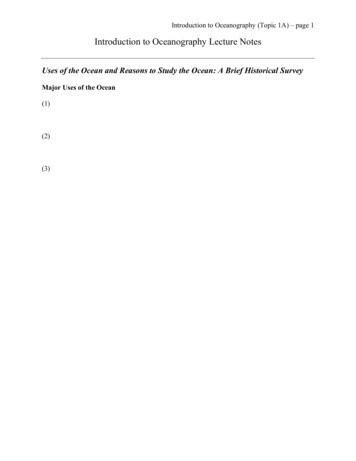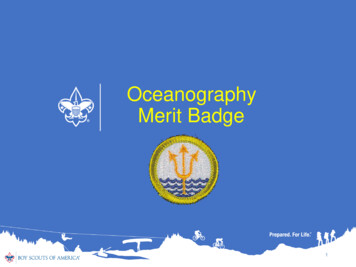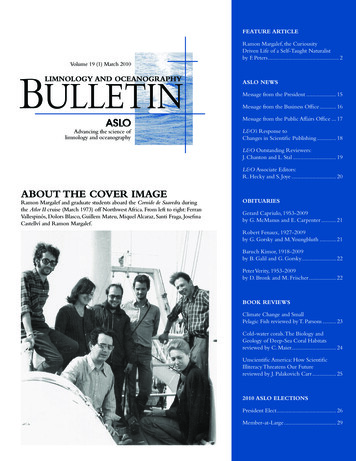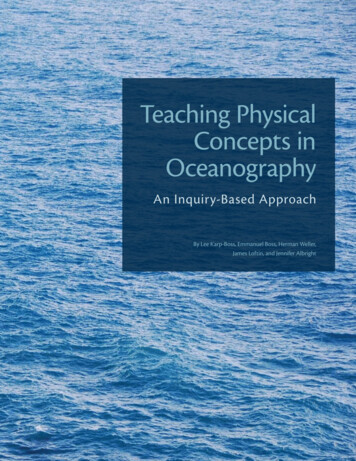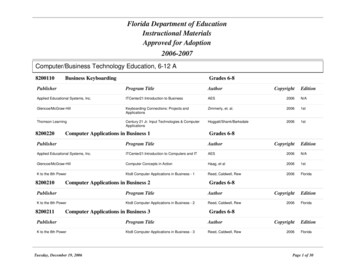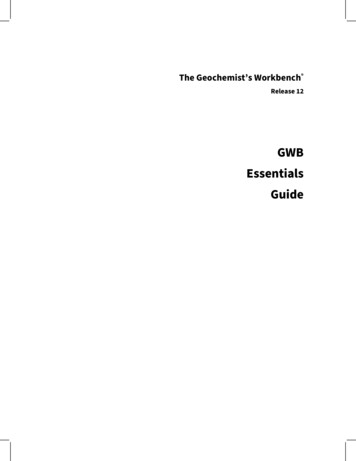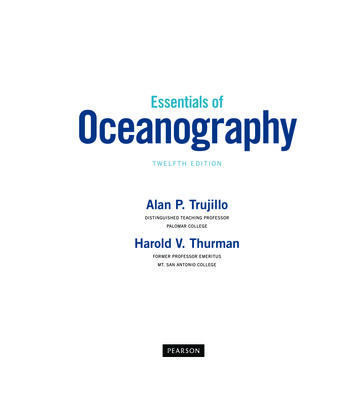
Transcription
Essentials ofOceanographyTwelfth EditionAlan P. TrujilloDistinguished Teaching ProfessorPalomar CollegeHarold V. ThurmanFormer Professor EmeritusMT. San Antonio CollegeA01 TRUJ7425 12 SE NASTAFM.indd 119/12/15 2:17 AM
Compositor: Lumina DatamaticsDesign Manager: Derek BacchusInterior Designer: Gary HespenheideCover Designer: Gary HespenheideIllustrators: International Mapping Associates, Peter Bull Art Studio, Justin HofmanRights & Permissions Management: Rachel YoudelmanPhoto Researcher: Kristin PiljayManufacturing Buyer: Maura Zaldivar-GarciaSenior Acquisitions Editor: Andrew DunawayExecutive Product Marketing Manager: Neena BaliExecutive Marketing Manager: Mary SalzmanProject Manager: Connie LongProgram Manager: Sarah ShefvelandDevelopment Editor: Barbara PriceArt Development Editor: Jay McElroyEditorial Assistant: Michelle KoskiDevelopment Manager: Jennifer HartProgram Management Team Lead: Kristen FlathmanProject Management Team Lead: David ZielonkaProduction Management: Lumina DatamaticsCover Photo Credit: Justin HofmanCopyright 2017, 2014, 2011 Pearson Education, Inc. All Rights Reserved. Printed in the United States of America. This publication isprotected by copyright, and permission should be obtained from the publisher prior to any prohibited reproduction, storage in a retrievalsystem, or transmission in any form or by any means, electronic, mechanical, photocopying, recording, or otherwise. For informationregarding permissions, request forms and the appropriate contacts within the Pearson Education Global Rights & Permissions department,please visit www.pearsoned.com/permissions/.Acknowledgements of third party content appear on page 586, which constitutes an extension of this copyright page.PEARSON, ALWAYS LEARNING,Pearson Education, Inc. or its affiliates.are exclusive trademarks in the United States and/or other countries owned byUnless otherwise indicated herein, any third-party trademarks that may appear in this work are the property of their respective owners andany references to third-party trademarks, logos, or other trade dress are for demonstrative or descriptive purposes only. Such referencesare not intended to imply any sponsorship, endorsement, authorization, or promotion of Pearson’s products by the owners of such marks,or any relationship between the owner and Pearson Education, Inc. or its affiliates, authors, licensees.Library of Congress Cataloging-in-Publication DataNames: Trujillo, Alan P. Thurman, Harold V.Title: Essentials of oceanography / Alan P. Trujillo, Distinguished TeachingProfessor, Palomar College, Harold V. Thurman, Professor Emeritus,Mt. San Antonio College.Description: Twelth edition. Boston : Pearson, [2018] Includesbibliographical references and index.Identifiers: LCCN 2015035841 ISBN 9780134073545 (alk. paper) ISBN0134073541 (alk. paper)Subjects: LCSH: Oceanography—Textbooks.Classification: LCC GC11.2 .T49 2018 DDC 551.46—dc23LC record available at http://lccn.loc.gov/20150358411 2 3 4 5 6 7 8 9 10—V311—18 17 16 15 14www.PearsonSchool.com/AdvancedA01 TRUJ7425 12 SE NASTAFM.indd 2ISBN 10: 0-13-426742-7; (High School Binding)ISBN 13: 978-0-134-26742-5 (High School Binding)19/12/15 2:17 AM
Dedicated to my father Dr. Anthony P. Trujillo,mentor, role model, teacher, and friend—Al TrujilloIn memory of Hal Thurman (1934–2012)A01 TRUJ7425 12 SE NASTAFM.indd 319/12/15 2:17 AM
About The AuthorsALAN P. TRUJILLO Al Trujillois a Distinguished Teaching Professor in the Earth, Space, andAviation Sciences Departmentat Palomar College in San Marcos, California. He received hisbachelor’s degree in geology fromthe University of California atDavis and his master’s degreein geology from Northern ArizonaUniversity, afterward working forseveral years in industry. Al beganteaching at Palomar in 1990. In1997, he was awarded Palomar’sDistinguished Faculty Award forExcellence in Teaching, and in 2005he received Palomar’s Faculty Research Award. He has coauthoredIntroductory Oceanography with Hal Thurman and is a contributing author for the textbooks Earth and Earth Science. In addition to writing and teaching, Al works as a naturalist and lectureraboard natural history expedition vessels for Lindblad Expeditions/National Geographic in Alaska, Iceland, and the Sea of Cortez/BajaCalifornia. His research interests include beach processes, sea clifferosion, and active teaching techniques. He enjoys photography,and he collects sand as a hobby. Al and his wife, Sandy, have twochildren, Karl and Eva.A01 TRUJ7425 12 SE NASTAFM.indd 4HAROLD V. THURMAN HalThurman’s interest in geologyled to a bachelor’s degree fromOklahoma A&M University, followed by seven years working asa petroleum geologist, mainly inthe Gulf of Mexico, where hisinterest in the oceans developed.He earned a master’s degree fromCalifornia State University at LosAngeles. Hal began teaching atMt. San Antonio College in Walnut, California, in 1968 as a temporary teacher and taught Physics1 (a surveying class) and threePhysical Geology labs. In 1970,he taught his first class of General Oceanography. It was from thisexperience that he decided to write a textbook on oceanography andreceived a contract with Charles E. Merrill Publishing Company in1973. The first edition of his book Introductory Oceanography wasreleased in 1975. Harold authored or coauthored over 20 editionsof textbooks that include Introductory Oceanography, Essentials ofOceanography, Physical Geology, Marine Biology, and Oceanography Laboratory Manual, many of which are still being used todaythroughout the world. In addition, he contributed to the World BookEncyclopedia on the topics of “Arctic Ocean,” “Atlantic Ocean,”“Indian Ocean,” and “Pacific Ocean.” Hal Thurman retired in May1994, after 24 years of teaching, and moved to be closer to familyin Oklahoma, then to Florida. Hal passed away at the age of 78 on December 29, 2012. His writing expertise, knowledge about theocean, and easy-going demeanor will be dearly missed.19/12/15 2:17 AM
Brief ContentsPreface xi1Introduction to Planet “Earth”2Plate Tectonics and the Ocean Floor3Marine Provinces4Marine Sediments5Water and Seawater6Air–Sea Interaction339817 Ocean Circulation1051371712078Waves and Water Dynamics9Tides24527910 Beaches, Shoreline Processes, and the Coastal Ocean11 Marine Pollution12347Marine Life and the Marine Environment37513 Biological Productivity and Energy Transfer14 Animals of the Pelagic Environment44515 Animals of the Benthic Environment47916The Oceans and Climate ChangeAfterword305403513550Appendix IMetric and English Units Compared 554Appendix IIGeographic Locations 558Appendix III Latitude and Longitude on Earth 560Appendix IV A Chemical Background: Why Water Has Two Hs and One O(Online as MasteringOceanography Bonus Web Content)Appendix VCareers in Oceanography 563Glossary 566Credits and Acknowledgments 586Index 589vA01 TRUJ7425 12 SE NASTAFM.indd 519/12/15 2:17 AM
ContentsPreface xiTo the Student xiDiving Deeper Preface.1 A User’s Guide for Students: How toRead a Science Textbook xiTo the Instructor xiiDiving Deeper Preface.2 Ocean Literacy: What Should PeopleKnow about the Ocean? xiiReorganization of What’s New in This Edition Section xiiiFor the Student xivFor the Instructor xivAcknowledgments xv1 Introduction To Planet “Earth”3E s s e n t i a l Le a r n i n g C o n ce p t s 31.1 How Are Earth’s Oceans Unique? 3Earth’s Amazing Oceans 4 How Many Oceans Exist on Earth? 4The Four Principal Oceans, Plus One 5 Oceans versus Seas 61.2 How Was Early Exploration of the Oceans Achieved? 9Early History 9Diving Deeper 1.1 Historical Feature How Do Sailors Know Where TheyAre at Sea? From Stick Charts to Satellites 10The Middle Ages 13 The Age of Discovery in Europe 13 The Beginning of Voyaging for Science 14 History ofOceanography . . . To Be Continued 151.3 What Is Oceanography? 161.4 What Is the Nature of Scientific Inquiry? 17Observations 17 Hypothesis 17 Testing 18 Theory 18 Theories and the Truth 181.5 How Were Earth and the Solar System Formed? 19The Nebular Hypothesis 20 Proto-Earth 20 Density and DensityStratification 22 Earth’s Internal Structure 221.6 How Were Earth’s Atmosphere and Oceans Formed? 26Origin of Earth’s Atmosphere 26 Origin of Earth’s Oceans 261.7 Did Life Begin in the Oceans? 27The Importance of Oxygen to Life 27 Stanley Miller’s Experiment 28 Evolution and Natural Selection 29 Plants and Animals Evolve 29Diving Deeper 1.2 Historical Feature The Voyage of HMS Beagle: How ItShaped Charles Darwin’s Thinking about the Theory of Evolution 301.8 How Old Is Earth? 33Radiometric Age Dating 33 The Geologic Time Scale 332 Plate Tectonics and the Ocean Floor39E s s e n t i a l Le a r n i n g C o n ce p t s 392.1 What Evidence Supports Continental Drift? 40Fit of the Continents 40 Matching Sequences of Rocks andMountain Chains 40 Glacial Ages and Other Climate Evidence 41 Distribution of Organisms 41 Objections to the ContinentalDrift Model 422.2 What Evidence Supports Plate Tectonics? 43Earth’s Magnetic Field and Paleomagnetism 44 Sea Floor Spreadingand Features of the Ocean Basins 46Diving Deeper 2.1 Research Methods in Oceanography Using Moving ontinents to RC esolve an A pparent Dilemma: Did Earth Ever Have Two Wandering North Magnetic Poles? 47Other Evidence from the Ocean Basins 49 Detecting Plate Motion with Satellites 53 The Acceptance of a Theory 532.3 What Features Occur at Plate Boundaries? 54Divergent Boundary Features 55 Convergent BoundaryFeatures 60 Transform Boundary Features 652.4 Testing the Model: How Can Plate Tectonics Be Used as a WorkingModel? 67Hotspots and Mantle Plumes 67 Seamounts and Tablemounts 70 Coral Reef Development 702.5 How Has Earth Changed in the Past, and How Will it Look in theFuture? 74The Past: Paleogeography 74 The Future: Some BoldPredictions 74 A Predictive Model: The Wilson Cycle 76Essential Concepts Review 78Essential Concepts Review 35viA01 TRUJ7425 12 SE NASTAFM.indd 619/12/15 2:17 AM
Contents vii3Marine Provinces81E s s e n t i a l Le a r n i n g C o n ce p t s 813.1 What Techniques Are Used to Determine Ocean Bathymetry? 81Soundings 82 Echo Soundings 82 Using Satellites to Map OceanProperties from Space 84 Seismic Reflection Profiles 853.2 What Features Exist on Continental Margins? 87Passive versus Active Continental Margins 87 ContinentalShelf 88 Continental Slope 89 Submarine Canyons and TurbidityCurrents 89 Continental Rise 913.3 What Features Exist in the Deep-Ocean Basins? 92Abyssal Plains 92 Volcanic Peaks of the Abyssal Plains 93 Ocean Trenches and Volcanic Arcs 933.4 What Features Exist along the Mid-Ocean Ridge? 95Volcanic Features 96 Hydrothermal Vents 96Diving Deeper 3.1 Research Methods in Oceanography Earth’sHypsographic Curve: Nearly Everything You Need to Know about Earth’sOceans and Landmasses in One Graph 97Diving Deeper 3.2 Research Methods in Oceanography Now You See It,Now You Don’t: Recovering Oceanographic Equipment Stuck in Lava 98Fracture Zones and Transform Faults 100 Oceanic Islands 101Essential Concepts Review 1024Marine Sediments105E s s e n t i a l Le a r n i n g C o n ce p t s 1054.1 How Are Marine Sediments Collected, and What Historical EventsDo They Reveal? 106Collecting Marine Sediments 106 Environmental ConditionsRevealed by Marine Sediments 108 Paleoceanography 1084.2 What Are the Characteristics of Lithogenous Sediment? 109Origin of Lithogenous Sediment 109 Composition of LithogenousSediment 109 Sediment Texture 110 Distribution of LithogenousSediment 1114.3 What Are the Characteristics of Biogenous Sediment? 113Origin of Biogenous Sediment 113 Composition of BiogenousSediment 114Diving Deeper 4.1 Oceans and People Diatoms: The Most ImportantThings You Have (Probably) Never Heard Of 115Distribution of Biogenous Sediment 1174.4 What Are the Characteristics of Hydrogenous Sediment? 121Origin of Hydrogenous Sediment 121 Composition and Distributionof Hydrogenous Sediment 1224.5 What Are the Characteristics of Cosmogenous Sediment? 124Origin, Composition, and Distribution of CosmogenousSediment 1244.6 How Are Pelagic and Neritic Deposits Distributed? 125Mixtures of Marine Sediment 125 Neritic Deposits 126Pelagic Deposits 126 How Sea Floor Sediments RepresentSurface Conditions 128 Worldwide Thickness of MarineSediments 1284.7 What Resources Do Marine Sediments Provide? 129Energy Resources 129 Other Resources 130Essential Concepts Review 133A01 TRUJ7425 12 SE NASTAFM.indd 75Water and Seawater137E s s e n t i a l Le a r n i n g C o n ce p t s 1375.1 Why Does Water Have Such Unusual Chemical Properties? 137Atomic Structure 137 The Water Molecule 1385.2 What Important Physical Properties Does Water Possess? 140Water’s Thermal Properties 140 Water Density as a Result ofThermal Contraction 1455.3 How Salty Is Seawater? 147Salinity 147 Determining Salinity 148Diving Deeper 5.1 Oceans and People How to Avoid Goiters 149Comparing Pure Water and Seawater 1505.4 Why Does Seawater Salinity Vary? 151Salinity Variations 151 Processes Affecting Seawater Salinity 152 Dissolved Components Added to and Removed from Seawater 1535.5 Is Seawater Acidic or Basic? 156The pH Scale 156 The Carbonate Buffering System 1575.6 How Does Seawater Salinity Vary at the Surface and with Depth? 158Surface Salinity Variation 159 Salinity Variation with Depth 159 Halocline 1605.7 How Does Seawater Density Vary with Depth? 161Factors Affecting Seawater Density 161 Temperature and DensityVariation with Depth 162 Thermocline and Pycnocline 1635.8 What Methods Are Used to Desalinate Seawater? 164Distillation 165 Membrane Processes 165 Other Methods ofDesalination 166Essential Concepts Review 1676 Air–Sea Interaction171E s s e n t i a l Le a r n i n g C o n ce p t s 1716.1 What Causes Variations in Solar Radiation on Earth? 172What Causes Earth’s Seasons? 172 How Latitude Affects theDistribution of Solar Radiation 173 Oceanic Heat Flow 1756.2 What Physical Properties Does the Atmosphere Possess? 175Composition of the Atmosphere 175 Temperature Variation inthe Atmosphere 176 Density Variation in the Atmosphere 176 Atmospheric Water Vapor Content 176 AtmosphericPressure 177 Movement of the Atmosphere 177 An Example:A Nonspinning Earth 1776.3 How Does the Coriolis Effect Influence Moving Objects? 178Example 1: Perspectives and Frames of Reference on aMerry-Go-Round 179 Example 2: A Tale of Two Missiles 180 Changes in the Coriolis Effect with Latitude 1816.4 What Global Atmospheric Circulation Patterns Exist? 181Circulation Cells 182 Pressure 183 Wind Belts 183 Boundaries 183 Circulation Cells: Idealized or Real? 1846.5 How Does the Ocean Influence Global Weather Phenomena andClimate Patterns? 185Weather versus Climate 186 Winds 186Diving Deeper 6.1 Historical Feature Why Christopher Columbus NeverSet Foot on North America 187Storms and Fronts 188 Tropical Cyclones (Hurricanes) 188 The Ocean’s Climate Patterns 1966.6 How Do Sea Ice and Icebergs Form? 198Formation of Sea Ice 198 Formation of Icebergs 20019/12/15 2:17 AM
viii Contents6.7 Can Power from Wind Be Harnessed as a Source of Energy? 201Essential Concepts Review 2027Ocean CirculationEssential Concepts Review 275207E s s e n t i a l Le a r n i n g C o n ce p t s 2079 Tides7.1 How Are Ocean Currents Measured? 207Surface Current Measurement 207Diving Deeper 7.1 Oceans and People Running Shoes asDrift Meters: Just Do It 209Deep Current Measurement 2107.2 What Creates Ocean Surface Currents and How Are TheyOrganized? 211Origin of Surface Currents 211 Main Components of OceanSurface Circulation 212 Other Factors Affecting Ocean SurfaceCirculation 214 Ocean Currents and Climate 2187.3 What Causes Upwelling and Downwelling? 220Diverging Surface Water 220 Converging Surface Water 220 Coastal Upwelling and Downwelling 220 Other Causes ofUpwelling 2217.4 What Are the Main Surface Circulation Patterns in Each OceanBasin? 222Antarctic Circulation 222 Atlantic Ocean Circulation 223Diving Deeper 7.2 Historical Feature Benjamin Franklin: The World’sMost Famous Physical Oceanographer 226Indian Ocean Circulation 227 Pacific Ocean Circulation 2297.5 How Do Deep-Ocean Currents Form? 236Origin of Thermohaline Circulation 236 Sources of Deep Water 236 Worldwide Deep-Water Circulation 2377.6 Can Power from Currents Be Harnessed as a Source ofEnergy? 240Essential Concepts Review 24188.6 Can Power from Waves Be Harnessed as a Sourceof Energy? 272Wave Power Plants and Wave Farms 272 Global Coastal WaveEnergy Resources 273Waves and Water Dynamics245E s s e n t i a l Le a r n i n g C o n ce p t s 2458.1 How Are Waves Generated, and How Do They Move? 245Disturbances Generate Ocean Waves 245 Wave Movement 2468.2 What Characteristics Do Waves Possess? 248Wave Terminology 248 Circular Orbital Motion 248 Deep-Water Waves 250 Shallow-Water Waves 251 Transitional Waves 2518.3 How Do Wind-Generated Waves Develop? 252Wave Development 252 Interference Patterns 256 Rogue Waves 2568.4 How Do Waves Change in the Surf Zone? 258Physical Changes as Waves Approach Shore 258 Breakers and Surfing 259 Wave Refraction 260 Wave Reflection 2628.5 How Are Tsunami Created? 263Coastal Effects 265 Some Examples of Historic and RecentTsunami 266 Tsunami Warning System 269Diving Deeper 8.1 Oceans and People Waves of Destruction: The 2011Japanese Tsunami 270A01 TRUJ7425 12 SE NASTAFM.indd 8279E s s e n t i a l Le a r n i n g C o n ce p t s 2799.1 What Causes Ocean Tides? 279Tide-Generating Forces 279 Tidal Bulges: The Moon’s Effect 282 Tidal Bulges: The Sun’s Effect 284 Earth’s Rotation and theTides 2849.2 How Do Tides Vary during a Monthly Tidal Cycle? 285The Monthly Tidal Cycle 285 Complicating Factors 287 Idealized Tide Prediction 2899.3 What Do Tides Look Like in the Ocean? 291Amphidromic Points and Cotidal Lines 291 Effect of theContinents 291 Other Considerations 2929.4 What Types of Tidal Patterns Exist? 292Diurnal Tidal Pattern 292 Semidiurnal Tidal Pattern 292 Mixed Tidal Pattern 2929.5 What Tidal Phenomena Occur in Coastal Regions? 294An Example of Tidal Extremes: The Bay of Fundy 294Diving Deeper 9.1 Oceans and People Tidal Bores: Boring Waves TheseAre Not! 295Coastal Tidal Currents 296 Whirlpools: Fact or Fiction? 297 Grunion: Doing What Comes Naturally on the Beach 2979.6 Can Tidal Power Be Harnessed as a Source of Energy? 299Tidal Power Plants 299Essential Concepts Review 30110 Beaches, Shoreline Processes, and theCoastal Ocean305E s s e n t i a l Le a r n i n g C o n ce p t s 30510.1 How Are Coastal Regions Defined? 305Beach Terminology 306 Beach Composition 30610.2 How Does Sand Move on the Beach? 307Movement Perpendicular to the Shoreline 307 Movement Parallel tothe Shoreline 30810.3 What Features Exist along Erosional and DepositionalShores? 310Features of Erosional Shores 310Diving Deeper 10.1 Oceans and People Warning: Rip C urrents . . . Do YouKnow What to Do? 312Features of Depositional Shores 31310.4 How Do Changes in Sea Level Produce Emerging and SubmergingShorelines? 319Features of Emerging Shorelines 320 Features of SubmergingShorelines 320 Changes in Sea Level 32010.5 How Does Hard Stabilization Affect Coastlines? 322Groins and Groin Fields 322 Jetties 323 Breakwaters 324 Seawalls 326 Alternatives to Hard Stabilization 32619/12/15 2:17 AM
Contents ix10.6 What are the Characteristics and Types of Coastal Waters? 328Characteristics of Coastal Waters 328 Estuaries 331 Lagoons 335 Marginal Seas 33610.7 What Issues Face Coastal Wetlands? 338Types of Coastal Wetlands 338 Characteristics of CoastalWetlands 340 Serious Loss of Valuable Wetlands 340Diving Deeper 12.1 Historical Feature Diving into the MarineEnvironment 39512.5 What Are the Main Divisions of the Marine Environment? 395Pelagic (Open Sea) Environment 396 Benthic (Sea Bottom)Environment 398Essential Concepts Review 399Essential Concepts Review 34211 Marine Pollution347E s s e n t i a l Le a r n i n g C o n ce p t s 34711.1 What Is Pollution? 347Marine Pollution: A Definition 348 Environmental Bioassay 348 The Issue of Waste Disposal in the Ocean 34911.2 What Marine Environmental Problems Are Associated withPetroleum Pollution? 349The 1989 Exxon Valdez Oil Spill 350 Other Oil Spills 350Diving Deeper 11.1 Focus on the Environment The 2010 Gulf ofMexico Deepwater Horizon Oil Spill 35211.3 What Marine Environmental Problems Are Associated withNon-Petroleum Chemical Pollution? 356Sewage Sludge 356 DDT and PCBs 357 Mercury and MinamataDisease 359 Other Types of Chemical Pollutants 36011.4 What Marine Environmental Problems Are Associated with Nonpoint Source Pollution, Including Trash? 362Non-point Source Pollution and Trash 362 Plastics as MarineDebris 36311.5 What Marine Environmental Problems Are Associated withBiological Pollution? 367The Seaweed Caulerpa taxifolia 367 Zebra Mussels 368 Other Notable Examples of Marine Biological Pollution 36811.6 What Laws Govern Ocean Ownership? 368Mare Liberum and the Territorial Sea 368 Law of theSea 369Essential Concepts Review 37112 Marine Life and the MarineEnvironment375E s s e n t i a l Le a r n i n g C o n ce p t s 37512.1 What Are Living Things, and How Are They Classified? 375A Working Definition of Life 375 The Three Domains of Life 376 The Six Kingdoms of Organisms 377 Linnaeus and TaxonomicClassification 37812.2 How Are Marine Organisms Classified? 379Plankton (Drifters) 380 Nekton (Swimmers) 381 Benthos (BottomDwellers) 38212.3 How Many Marine Species Exist? 383Why Are There So Few Marine Species? 384 Species in Pelagic andBenthic Environments 38412.4 How Are Marine Organisms Adapted to the Physical Conditions ofthe Ocean? 385Need for Physical Support 385 Water’s Viscosity 386 Temperature 387 Salinity 389 Dissolved Gases 391 Water’s High Transparency 392 Pressure 394A01 TRUJ7425 12 SE NASTAFM.indd 913 Biological Productivity and EnergyTransfer403E s s e n t i a l Le a r n i n g C o n ce p t s 40313.1 What Is Primary Productivity? 403Measurement of Primary Productivity 404 Factors AffectingPrimary Productivity 404 Light Transmission in OceanWater 406 Why Are the Margins of the Oceans So Richin Life? 40813.2 What Kinds of Photosynthetic Marine Organisms Exist? 411Seed-Bearing Plants (Anthophyta) 411 Macroscopic (Large)Algae 411 Microscopic (Small) Algae 413 Ocean Eutrophicationand Dead Zones 416 Photosynthetic Bacteria 41813.3 How Does Regional Primary Productivity Vary? 419Productivity in Polar (High Latitude) Oceans: 60 to 90 degreesNorth and South Latitude 420 Productivity in Tropical(Low-Latitude) Oceans: 0 to 30 degrees North and SouthLatitude 421 Productivity in Temperate (Middle Latitude) Oceans:30 to 60 degrees North and South Latitude 422 ComparingRegional Productivity 42413.4 How Are Energy and Nutrients Passed Along in MarineEcosystems? 424Flow of Energy in Marine Ecosystems 424 Flow of Nutrients inMarine Ecosystems 425 Oceanic Feeding Relationships 42613.5 What Issues Affect Marine Fisheries? 430Marine Ecosystems and Fisheries 430 Overfishing 430 IncidentalCatch 432Diving Deeper 13.1 Focus on the Environment Fishing down the FoodWeb: Seeing Is Believing 433Fisheries Management 435 Effect of Global Climate Change onMarine Fisheries 439 Seafood Choices 440Essential Concepts Review 44114 Animals of The Pelagic Environment445E s s e n t i a l Le a r n i n g C o n ce p t s 44514.1 How Are Marine Organisms Able to Stay Above the Ocean Floor? 445Use of Gas Containers 445 Ability to Float 446 Ability toSwim 447 The Diversity of Planktonic Animals 44714.2 What Adaptations Do Pelagic Organisms Possess for SeekingPrey? 452Mobility: Lungers versus Cruisers 452 Swimming Speed 453Diving Deeper 14.1 Oceans and People Some Myths (and Facts) aboutSharks 454Adaptations of Deep-Water Nekton 45514.3 What Adaptations Do Pelagic Organisms Possess to Avoid BeingPrey? 456Schooling 457 Symbiosis 458 Other Adaptations 45819/12/15 2:17 AM
x Contents14.4 What Characteristics Do Marine Mammals Possess? 459Mammalian Characteristics 459 Order Carnivora 460 OrderSirenia 462 Order Cetacea 46214.5 An Example of Migration: Why Do Gray Whales Migrate? 472Migration Route 472 Reasons for Migration 472 Timing ofMigration 473 Are Gray Whales an Endangered Species? 473 Whaling and the International Whaling Commission 474Essential Concepts Review 47515 Animals of the Benthic Environment479E s s e n t i a l L e a r n i n g C o n c e p t s 47915.1 What Communities Exist along Rocky Shores? 479Intertidal Zonation 480 The Spray (Supratidal) Zone: Organismsand Their Adaptations 484 The High Tide Zone: Organisms andTheir Adaptations 484 The Middle Tide Zone: Organisms andTheir Adaptations 484 The Low Tide Zone: Organisms and TheirAdaptations 48615.2 What Communities Exist along Sediment-Covered Shores? 487Physical Environment of the Sediment 488 Intertidal Zonation 488 Sandy Beaches: Organisms and Their Adaptations 488 Mud Flats:Organisms and Their Adaptations 48915.3 What Communities Exist on the Shallow Offshore Ocean Floor? 490Rocky Bottoms (Subtidal): Organisms and Their Adaptations 490 Coral Reefs: Organisms and Their Adaptations 49315.4 What Communities Exist on the Deep-Ocean Floor? 500The Physical Environment 500 Food Sources and SpeciesDiversity 501 Deep-Sea Hydrothermal Vent Biocommunities:Organisms and Their Adaptations 501Diving Deeper 15.1 Research Methods in Oceanography How LongWould Your Remains Remain on the Sea Floor? 502Low-Temperature Seep Biocommunities: Organisms and TheirAdaptations 507 The Deep Biosphere: A New Frontier 50916.2 Earth’s Recent Climate Change: Is It Natural or Caused by HumanInfluence? 516Determining Earth’s Past Climate: Proxy Data andPaleoclimatology 516 Natural Causes of Climate Change 516 The IPCC: Documenting Human-Caused Climate Change 52016.3 What Causes the Atmosphere’s Greenhouse Effect? 523Earth’s Heat Budget and Changes in Wavelength 523 Which GasesContribute to the Greenhouse Effect? 524Diving Deeper 16.1 Research Methods in Oceanography The IconicKeeling Curve of Atmospheric Carbon Dioxide and the Father–Son Team WhoCreated It 526Other considerations: Aerosols 529 What Documented Changes AreOccurring Because of Global Warming? 53016.4 What Changes Are Occurring in the Oceans as a Result of GlobalWarming? 531Increasing Ocean Temperatures 531 Changes in Deep-WaterCirculation 534 Melting of Polar Ice 534 Recent Increase inOcean Acidity 536 Rising Sea Level 539 Other Predicted andObserved Changes 54016.5 What Should Be Done to Reduce Greenhouse Gases? 542The Ocean’s Role in Reducing Global Warming 543 Possibilitiesfor Reducing Greenhouse Gases 543 The Kyoto Protocol: LimitingGreenhouse Gas Emissions 546Essential Concepts Review 547Afterword 550Appendix IMetric and English Units Compared 554Appendix II Geographic Locations 558Appendix III Latitude and Longitude on Earth 560Appendix IV A Chemical Background: Why Water Has Two Hs and One O(Online as MasteringOceanography Bonus Web Content)Appendix V Careers in Oceanography 563Glossary 566Essential Concepts Review 510Credits and Acknowledgments 58616 The Oceans and Climate Change513Index 589E s s e n t i a l L e a r n i n g C o n c e p t s 51316.1 What Comprises Earth’s Climate System? 513A01 TRUJ7425 12 SE NASTAFM.indd 1019/12/15 2:22 AM
Preface“ The sea, once it casts its spell, holds one in its net ofwonder forever.”—Jacques-Yves Cousteau, oceanographer, underwatervideographer, and explorer (circa 1963)To the StudentWelcome! You’re about to embark on a journey that is far from ordinary. Over the course of this term, you will discover the central rolethe oceans play in the vast global system of which you are a part.This book’s content was carefully developed to provide a foundation in science by examining the vast body of oceanic knowledge.This knowledge includes information from a variety of scientific disciplines—geology, chemistry, physics, and biology—as they relate toDiving Deeperthe oceans. However, no formal background in any of these disciplinesis required to successfully master the subject matter contained withinthis book. Our desire is to have you take away from your oceanographycourse much more than just a collection of facts. Instead, we want youto develop a fundamental understanding of how the oceans work andwhy the oceans behave the way that they do.This book is intended to help you in your quest to know moreabout the oceans. Taken as a whole, the components of the ocean—its sea floor, chemical constituents, physical components, and lifeforms—comprise one of Earth’s largest interacting, interrelated, andinterdependent systems. Because human activities impact Earth systems, it is important to understand not only how the oceans operatebut also how the oceans interact with Earth’s other systems (such as itsatmosphere, biosphere, and hydrosphere) as part of a larger picture.Thus, this book uses a systems approach to highlight the interdisciplinary relationships among oceanographic phenomena and how thosephenomena affect other Earth systems.Preface.1A User’s Guide for Students: How To Read a Science TextbookHave you known someone who could scan areading assignment or sleep with it undertheir pillow and somehow absorb all the information? Studies have shown that those peoplehaven’t really committed anything to long-termmemory. For most of us, it takes a focused,concentrated effort to gain knowledge throughreading. Interestingly, if you have the propermotivation and reading techniques, you can develop excellent reading comprehension. What isthe best way to read a science textbook such asthis one that contains many new and unfamiliarterms?One common mistake is to approach reading a science textbook as one would read anewspape
1973. The first edition of his book Introductory Oceanography was released in 1975. Harold authored or coauthored over 20 editions of textbooks that include Introductory OceanographyEssentials of , Oceanography, Physical Geology, Marine Biology, and Oceanogra-phy Laboratory Manual,
